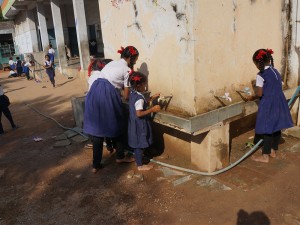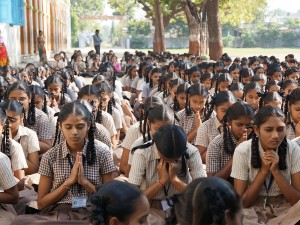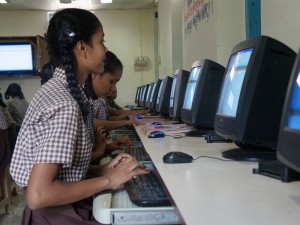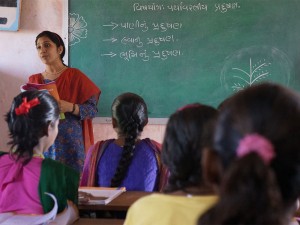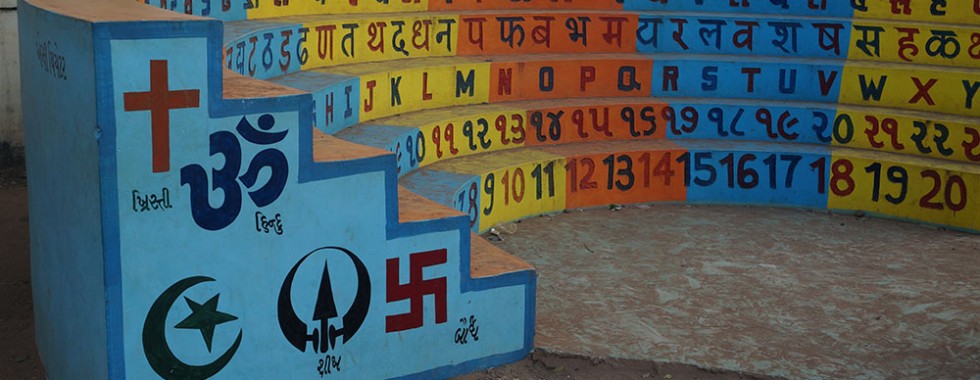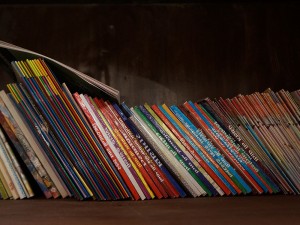Brighter Futures
Following extensive research carried out of schools in the district of Anand (Gujarat, India) requiring voluntary help, CFDC engaged and agreed a week long voluntary programme with the principles of three government schools.
Over 40 UK volunteers took part in a seven day programme to change the lives of over 1,600 children and their families. The programme called Brighter Futures, is what we hoped to give the communities involved.
The programme was split into three projects; Rejuvenate, Inspire and Motivate.
REJUVENATE
Bakrol Girls School is a government school based on the perimeter of Anand, providing educational facilities to 250 girls. Unfortunately the school is an old establishment in terms of teaching staff and fairly uninspiring in terms of play and recreational facilities.
Change Delivered
Volunteers created a safe and happy play area for the girls, located on top of a disused roof terrace on the existing building. The area was secured with high wire fencing and perimeter walls painted by mixed groups of volunteers and children, using designs produced by the children. The whole area is covered with a canopy to provide shelter against the heat and rain, making this a lovely space for the girls to enjoy all year round. The completion of the playground was celebrated with a grand opening ceremony and is still in constant use.
INSPIRE
NL Patel High School is a part government/part trust funded, mixed sex school in Napad, run by a strong principal. The school educates approximately 1,100 children from nearby villages where parents are predominantly employed as labourers. The school grounds have been donated by the community and are open to them after school hour.
Change Delivered
Volunteers and children created an educational garden featuring miniature key landmarks from around the world. The garden features, The Eiffel Tower, Terracotta Army, Taj Mahal, Sydney Opera House and Big Ben, among other landmarks. The base of each sculpture provides key facts about the country the landmark, population, language and national sport. The garden is planned around gravel pathways (donated by London Stone www.londonstone.co.uk) and points the direction and distance of the landmark country from India.)
MOTIVATE
This is a mixed sex government school in Dampura, servicing 250 children. The school is managed by a young principal whose values and teaching systems stand out from all the other schools visited, being both inspiring and energetic. The children are very well behaved and from the poorest background of all three schools.
Change Delivered
Volunteers created a sanctuary for the children in the form of a library that also serves as an interactive (Smart) classroom. An unused classroom was transformed into a room filled with books, desks, computers and break-out areas. Use of interactive facilities has improved the children’s ability to concentrate and learn. Old classroom style teaching is replaced by showing educational film on screen, followed by group discussion and debate.
Research
The Brighter Futures programme was developed after visiting a number of schools in the district of Anand in India during December 2014. The purpose of these visits was to identify schools requiring the help of 40 volunteers from the UK. In this search, we found that government schools located in most rural places were operating on the most limited resources. Some children attending these schools were from single parent families, orphaned, or children of families on little or no income. Unfortunately alcohol consumption is very high and some parents earning 100 rupees a day would spend a quarter of this on un-refined alcohol ‘moonshine’. The number of girls attending school in the 9th & 10th grade is dramatically reduced. This could be because at this age, education is no longer compulsory or the girls are pulled out of school and put to domestic work, in order to supplement the family income. Most of these families live below the poverty line and are in possession of a BPL card (Below Poverty Line), which allows them free medical care.
During our visit, we spoke to a number of teachers and principals and discovered that in most government schools they already have an assistance program underway. This includes increasing the number of class rooms, provision of 11 computers, internet connection, a free midday meal and a small amount of cash to buy a school uniform.
In a drive to improve the quality of education, the government has also placed many younger teachers in the role of principal and there is a three year rotation of head teachers. This replaces the former practice where head teachers were promoted due to years of service. Most new appointments have gained their position by sitting exams to prove their ability in the role.
Once every three years the government identifies a school with potential, meeting certain parameters and invests 300,000 rupees to transform it into a ‘Bala’ school. A Bala school is painted throughout with educational material on every wall and includes structures such as an outdoor theatre which all combine to make the school a place of refuge for troubled children. All schools hope to be chosen for this scheme but so far very few have been transformed.
We found that government schools continue to be the only place of education for the most poorest of society and are extremely underfunded. The most obvious need is for technology teachers, the government provides computers but no dedicated IT teacher as they work on rotation covering several schools in the area and visit each school only once a week. This is obviously inadequate and negates the benefit of providing computer facilities. We are pleased to report that from 2015, CFDC sponsored by Powa Technologies are going to fund the cost of an IT teacher for Bakrol Girls and Dampura Schools for two years, to maximise the benefits of the computers facilities and build a long term relationship with the schools.
During our search, CFDC were also able to fund 20 libraries in government managed schools in Gujarat (India) via Anand Rotary scheme and provided 130 fleeces to some very under privileged children in Devkapur School. These items were funded by friends and family in memory of the late Hema Patel. Both donations have been put to good use with children taking books home to enjoy with their families and the fleeces protecting children in the rural farmland around Devkapur school.


